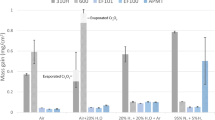Abstract
In order to study the effects on oxidation behavior of changing thecomposition of oxide scales without changing the composition of theunderlying alloys, thin films, which contained various amounts of Y2O3,Cr2O3, or Al2O3 have been deposited on Fe–25%Cr andFe–25%Cr–5%Al prior to oxidation. There were major differencesbetween the (Fe–25%Cr)–(Cr2O3–Y2O3) and(Fe–25%Cr–5%Al)–(Al2O3–Y2O3) systems. A film ofCr2O3 on Fe–25%Cr reduced the oxidation rate and Cr2O3–Y2O3films reduced it still further. A film of Al2O3 onFe–25%Cr–5%Al reduced the rate considerably, butAl2O3–Y2O3 films exhibited rates that were greater than those forAl2O3 alone. A film, which consisted entirely of Y2O3, greatly decreasedthe oxidation rate of Fe–25%Cr, but increased that ofFe–25%Cr–5%Al. The changes in oxidation rate produced byY2O3 in the (Fe–25%Cr)–(Cr2O3–Y2O3) system weremuch greater than those produced in the(Fe–25%Cr–5%Al)–(Al2O3–Y2O3) system. As far asoxidation rate is concerned, the optimum amount of Y2O3 in the(Fe–25%Cr)–(Cr2O3–Y2O3) system was found to begreater than or equal to 40% and less than 100%; in theFe–25%Cr–5%Al)–(Al2O3–Y2O3) systemit was approximately 10%. In thermal-cycling tests, the resultsfor the (Fe–25%Cr)–(Cr2O3–Y2O3) system followedthe same pattern as that for the isothermal tests; a film of Y2O3reduced the oxidation rate and a film of Cr2O3–33%Y2O3reduced it still further.
Similar content being viewed by others
REFERENCES
D. G. Barnes, J. M. Calvert, D. G. Lees and P. J. Parry, Scripta Met., 8, 1209 (1974).
T. N. Rhys-Jones, H. J. Grabke and H. Kudielka, Corrosion Science, 27, 49 (1987).
D. P. Moon and M. J. Bennett, Materials Science Forum, 43, 269 (1989).
P. Y. Hou and J. Stringer, J. Electrochem. Soc., 134, 1836 (1987).
Y. D. He and F. H. Stott, Corrosion Science, 36, 1869 (1994).
Y. D. He, C. H. Chen, H. B. Qi and R. Z. Zhu, Proceedings of Academic Conference of Chinese Society for Corrosion and Protection, p. 69 (1994).
R. J. Hussey and M. J. Graham, Oxid. Met., 45, 349 (1996).
R. L. Nelson, J. D. F. Ramsay, J. L. Woodhead, J. A. Cairns and J. A. A. Crossley, Thin Solid Films, 81, 329 (1981).
M. F. Stroosnijder, Thesis, Delft Technical University, 1990.
X. Y. Lu, Y. D. He and R. Z. Zhu, China Patent, 93 1001181.1 (1993).
M. Skeldon, J. M. Calvert and D. G. Lees, Oxid. Met. 28, 109 (1987).
D. G. Lees, Oxid. Met. 27, 75 (1987).
P. Skeldon, J. M. Calvert and D. G. Lees, Phil. Trans. R. Soc. Lond. A296, 557 (1980).
W. Dong, D. G. Lees and G. W. Lorimer, Oxid. Met. To be published.
Author information
Authors and Affiliations
Rights and permissions
About this article
Cite this article
Qi, H.B., Lees, D.G. The Effects of Surface-Applied Oxide Films Containing Varying Amounts of Yttria, Chromia, or Alumina on the High-Temperature Oxidation Behavior of Chromia-Forming and Alumina-Forming Alloys. Oxidation of Metals 53, 507–527 (2000). https://doi.org/10.1023/A:1004633026323
Issue Date:
DOI: https://doi.org/10.1023/A:1004633026323




